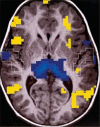Functional magnetic resonance imaging of hearing-impaired children under sedation before cochlear implantation
- PMID: 17638781
- PMCID: PMC2763405
- DOI: 10.1001/archotol.133.7.677
Functional magnetic resonance imaging of hearing-impaired children under sedation before cochlear implantation
Abstract
Objective: To investigate functional magnetic resonance imaging (fMRI) in pediatric cochlear implantation candidates with residual hearing who are under sedation for evaluation of auditory function.
Design: During fMRI, subjects heard a random sequence of tones (250-4000 Hz) presented 10 dB above hearing thresholds. Tones were interleaved with silence in a block-periodic fMRI design with 30-second on-off intervals. Twenty-four axial sections (5 mm thick) covering most of the brain were obtained every 3 seconds for a total acquisition time of 5.5 minutes.
Setting: Single tertiary academic medical institution.
Patients: Severely to profoundly hearing-impaired children (n=10; mean age, 49.1 months). During fMRI, subjects were awake (n=2) or sedated with pentobarbital sodium if their weight was 10 kg or greater (n=4) or chloral hydrate if their weight was less than 10 kg (n=4).
Main outcome measures: Detection of brain activation by fMRI in the primary auditory cortex (A1) in hearing-impaired patients under sedation, and correlation of A1 activation with hearing levels measured after cochlear implantation.
Results: In most subjects, fMRI detected significant levels of activation in the A1 region before cochlear implantation. The improvement in hearing threshold after cochlear implantation correlated strongly (linear regression coefficient, R=0.88) with the amount of activation in the A1 region detected by fMRI before cochlear implantation.
Conclusions: Functional MRI can be considered a means of assessing residual function in the A1 region in sedated hearing-impaired toddlers. With improvements in acquisition, processing, and sedation methods, fMRI may be translated into a prognostic indicator for outcome after cochlear implantation in infants.
Figures


Similar articles
-
[Functional evaluation of auditory cortex by functional magnetic resonance before cochlear implantation: a pilot study].Zhonghua Er Bi Yan Hou Tou Jing Wai Ke Za Zhi. 2014 Oct;49(10):821-7. Zhonghua Er Bi Yan Hou Tou Jing Wai Ke Za Zhi. 2014. PMID: 25567437 Chinese.
-
Hearing Preservation in Pediatric Cochlear Implantation.Otol Neurotol. 2017 Jul;38(6):e128-e133. doi: 10.1097/MAO.0000000000001444. Otol Neurotol. 2017. PMID: 28538468
-
Auditory cortical responses evoked by pure tones in healthy and sensorineural hearing loss subjects: functional MRI and magnetoencephalography.Chin Med J (Engl). 2006 Sep 20;119(18):1548-54. Chin Med J (Engl). 2006. PMID: 16996009
-
Functional magnetic resonance imaging: contemporary and future use.Curr Opin Otolaryngol Head Neck Surg. 2004 Oct;12(5):374-7. doi: 10.1097/01.moo.0000136874.64501.5f. Curr Opin Otolaryngol Head Neck Surg. 2004. PMID: 15377946 Review.
-
Identification of Pure-Tone Audiologic Thresholds for Pediatric Cochlear Implant Candidacy: A Systematic Review.JAMA Otolaryngol Head Neck Surg. 2018 Jul 1;144(7):630-638. doi: 10.1001/jamaoto.2018.0652. JAMA Otolaryngol Head Neck Surg. 2018. PMID: 29800000
Cited by
-
Functional MRI in children: clinical and research applications.Pediatr Radiol. 2010 Jan;40(1):31-49. doi: 10.1007/s00247-009-1452-x. Epub 2009 Nov 24. Pediatr Radiol. 2010. PMID: 19937236 Review.
-
Structural neuroimaging of the altered brain stemming from pediatric and adolescent hearing loss-Scientific and clinical challenges.Wiley Interdiscip Rev Syst Biol Med. 2020 Mar;12(2):e1469. doi: 10.1002/wsbm.1469. Epub 2019 Dec 4. Wiley Interdiscip Rev Syst Biol Med. 2020. PMID: 31802640 Free PMC article. Review.
-
FMRI under sedation: what is the best choice in children?J Clin Med Res. 2012 Dec;4(6):363-70. doi: 10.4021/jocmr1047w. Epub 2012 Nov 11. J Clin Med Res. 2012. PMID: 23226168 Free PMC article.
-
Hearing loss and dementia: radiologic and biomolecular basis of their shared characteristics. A systematic review.Neurol Sci. 2021 Feb;42(2):579-588. doi: 10.1007/s10072-020-04948-8. Epub 2021 Jan 7. Neurol Sci. 2021. PMID: 33409831
-
Brain Plasticity Can Predict the Cochlear Implant Outcome in Adult-Onset Deafness.Front Hum Neurosci. 2019 Feb 19;13:38. doi: 10.3389/fnhum.2019.00038. eCollection 2019. Front Hum Neurosci. 2019. PMID: 30837852 Free PMC article.
References
-
- Kemper AR, Downs SMA. Cost-effectiveness analysis of newborn hearing screening strategies. Arch Pediatr Adolesc Med. 2000;154(5):484–488. - PubMed
-
- Cunningham M, Cox EO. Hearing assessment in infants and children: recommendations beyond neonatal screening. Pediatrics. 2003;111(2):436–440. - PubMed
-
- Bachmann KR, Arvedson JC. Early identification and intervention for children who are hearing impaired. Pediatr Rev. 1998;19(5):155–165. - PubMed
-
- Northern JL. Universal screening for infant hearing impairment [comment]. Pediatrics. 1994;94(6 pt 1):955. - PubMed
-
- Moeller MP, Osberger MJ, Eccarius M. Language and learning skills of hearing-impaired students: receptive language skills. ASHA Monogr. 1986 March;(23):41–53. - PubMed
Publication types
MeSH terms
Substances
Grants and funding
LinkOut - more resources
Full Text Sources
Medical
Miscellaneous

